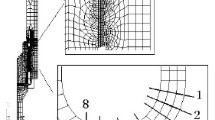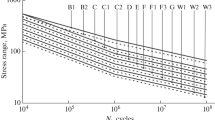Abstract
In this paper, creep-fatigue damage under elevated temperatures is investigated for a tube sheet-to-shell structure, which is one of the main structures under Gen-IV class 1 components. To do this, detailed step-by-step procedures, including the elastic structural analysis and the ASME-NH code application, are described for a defined representative load cycle. From the sensitivity studies for various design parameters, such as hold time duration, shell thickness, and operating temperature, it is found that a reduction of thickness can decrease the thermal bending stresses, but the negative effect is that it may increase the primary stress and enhance the creep damage. The normal operating temperature is the most significant parameter in the creep-fatigue design.
Similar content being viewed by others
References
ASME Boiler and Pressure Vessel Code, Section III, Subsection NH, (2007).
RCC-MR, Design and Construction Rules for Mechanical Components of FBR Nuclear Islands, AFCEN (2002).
Elevated Temperature Structural Design Guide for Class 1 Components of Prototype Fast Breeder Reactor, PNC N241-84-08, PNC, (1984).
G. H. Koo and B. Yoo, Elevated Temperature Design of KALIMER Reactor Internals Accounting for Creep and Stress Rupture Effects, Journal of the Korean Nuclear Society, 32(6) (2000) 566–594.
G. H. Koo and B. Yoo, Evaluation of Creep-Fatigue damage of KALIMER Reactor Internals Using the Elastic Analysis Method in RCC-MR, Journal of the Korean Nuclear Society, 33(6) (2001) 566–584.
G. H. Koo and J. H. Lee, Development of an ASME-NH Program for Nuclear Component Design at Elevated Temperatures, International Journal of pressure Vessels and Piping, 85 (2008) 385–393.
G. H. Koo and J. H. Lee, Computer Program of SIE ASMENH Code, KAERI/TR-3526/2008, KAERI, (2008).
ANSYS User’s Manual, Volume I and II.
Author information
Authors and Affiliations
Corresponding author
Additional information
This paper was recommended for publication in revised form by Associate Editor Jooho Choi
Gyeong-Hoi Koo received a Ph.D in Mechanical Engineering from KAIST in 1996. He is a principal researcher in KAERI (Korea Atomic Energy Research Institute) since 1989. His expertise in fields of structural engineering are structural vibration, seismic analysis, creep-fatigue design by analysis, buckling analysis, and fatigue monitoring system. Recently he is endorsed as a committee member of ASME Codes and Standards for elevated temperature design for Gen-IV reactors.
Rights and permissions
About this article
Cite this article
Koo, GH., Lee, JH. Creep-fatigue design studies for a sodium-cooled fast reactor with tube sheet-to-shell structure subjected to elevated temperature service. J Mech Sci Technol 24, 711–719 (2010). https://doi.org/10.1007/s12206-010-0121-1
Received:
Revised:
Accepted:
Published:
Issue Date:
DOI: https://doi.org/10.1007/s12206-010-0121-1




